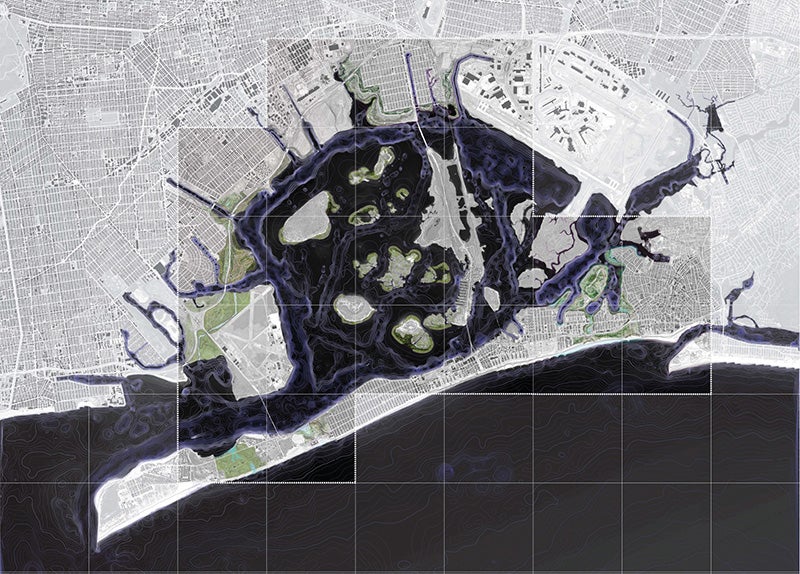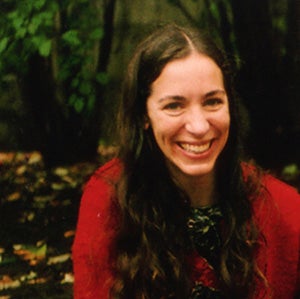A landscape architecture professor from the City College of New York will visit UO January 11 to discuss the devastating effects of climate change on shoreline communities and why humans need to “adapt to a much more flexible and amphibious way of living at the coast.”
Seavitt Nordenson will discuss the design strategies she developed with her CCNY team to restore the urban ecology of Jamaica Bay Wildlife Refuge in New York and to make coastal regions more resistant to environmental threats. She will also address how landscape architects play a key role in this effort.
Her lecture will take place at 5:30 p.m. on Monday, January 11, at the Lee Barlow Giustina Ballroom in the Ford Alumni Center. The lecture, free and open to the public, is preceded by a reception at 5 p.m. The event is hosted by the Fuller Center for Productive Landscapes at the University of Oregon.

Above: Research by Catherine Seavitt Nordenson focuses on design adaptation to sea level rise in urban coastal environments such as Jamaica Bay National Wildlife Refuge, shown here. Image courtesy Catherine Seavitt Nordenson.
In summer 2015, the UO’s Overlook Field School, part of the Fuller Center, brought ten students to the Jamaica Bay Wildlife Refuge, a 14-square-mile area of wetlands in New York City, where they witnessed some of the lasting devastation from 2012’s Hurricane Sandy during a tour led by Seavitt Nordenson and Don Riepe, director of the Northeast Chapter of the American Littoral Society.
“There’s no better way to comprehend the vast scale of Jamaica Bay than being physically present right in the middle of it all, as we did with the Overlook Field School,” says Seavitt Nordenson.
Jamaica Bay’s wetlands provide New York City with critical natural defenses against hurricanes and other natural disasters by storing floodwater and reducing wave damage. But the wetlands have been disappearing since the early 20th century and, according to an article in Landscape Architecture, the U.S. Army Corps of Engineers predicts that without human intervention the marshlands will disappear by 2025.
Seavitt Nordenson’s research aims to identify what measures can be taken to mitigate the severe climate patterns threatening the region. These include reintroducing ocean-to-bay water circulation and flow via “overwash plains” and establishing terraces at marsh perimeters.
“Catherine’s work is creative as well as based on sound science and adds to the development of plans to make the New York City coastline more resilient,” Riepe says.
Seavitt Nordenson says the barrier island of Rockaway Peninsula can work as “a dynamic entity that enables an exchange of ocean and bay ecosystems within a watershed. … We as humans will need to adapt to a much more flexible and amphibious way of living at the coast.”
In 2010, Seavitt Nordenson contributed to the research project “On The Water: Palisade Bay” and helped curate “Rising Currents,” an exhibition at the New York’s Museum of Modern Art, both of which focused on the New York waterfront and its ability to recover from or adapt to rising sea levels.
“[Rising Currents] was a key exhibition and a key event for the discipline to consider how we as designers can more rigorously incorporate climate change predictions in our designs, and what that means for urban resilience,” says Roxi Thoren, director of the Fuller Center and associate professor of landscape architecture at the UO. “[Seavitt Nordenson’s] work is foundational to that way of thinking, which is a sea change in the discipline.”
Hurricane Sandy’ $50 billion in devastation demonstrated that communities were not prepared to face natural disasters. It also showed how certain vulnerable populations are sidelined in the recovery process.
“As landscape architects, we have to talk about how an ecosystem’s health and social justice often go tightly hand in hand,” Thoren says. “Wealthy communities have a capacity to respond and poorer communities do not.”
 The work of Catherine Seavitt Nordenson, associate professor at CCNY’s Graduate Program of Landscape Architecture, focuses on how landscape and urban design can incorporate natural methods to adapt to rising sea levels, increased storm surges, and other coastal issues related to climate change.
The work of Catherine Seavitt Nordenson, associate professor at CCNY’s Graduate Program of Landscape Architecture, focuses on how landscape and urban design can incorporate natural methods to adapt to rising sea levels, increased storm surges, and other coastal issues related to climate change.
While hurricane and flood mitigation are primarily an East Coast issue, tsunami risk from an underwater earthquake along the Cascadia Subduction Zone is a critical issue for Oregon. Unlike flooding from hurricanes, which are tracked for weeks prior to landfall and for which evacuation systems are in place, the warning time for a tsunami is, at most, thirty minutes—a frightening prospect, says Nordenson. She also points to deforestation along coastal Oregon as a serious issue; these forests can serve as a natural defense against massive waves.
The Overlook Field School will investigate the impact that animals have in shaping a natural landscape during its annual visit to northeastern Pennsylvania this summer. Applications for the field school are being accepted through the end of January.
The Fuller Center for Productive Landscapes is a program of the University of Oregon’s Department of Landscape Architecture. The Center is a living laboratory for exploring the role of place in cultural sustainability. Learn more at landarch.uoregon.edu/fuller-center.
